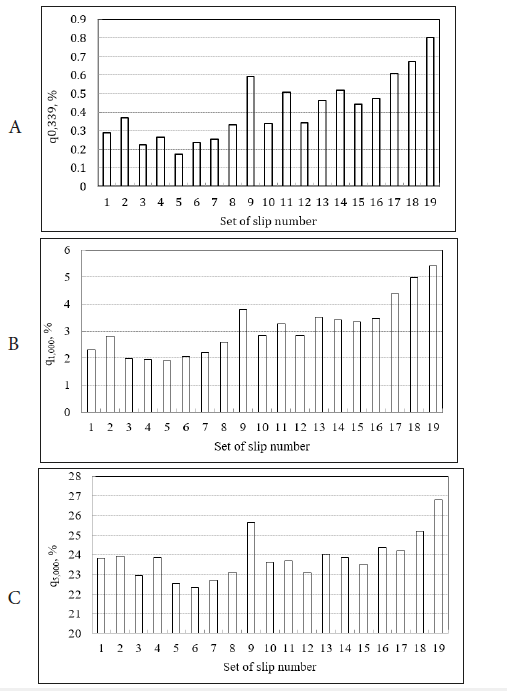- Submissions

Full Text
Research & Development in Material Science
Quantitative Content of a Colloidal Component in a Quartz Glass Based Slip Determination
Kharitonov DV1,2*, Anashkina AA1,2 and Motornova MS1,2
1JSC «ORPE «Technologiya» named after AG Romashin, Obninsk, Russia
2D. Mendeleyev University of Chemical Technology of Russia, Moscow, Russia
*Corresponding author:Kharitonov DV, JSC «ORPE «Technologiya» named after AG Romashin, Obninsk, Russia
Submission: May 17, 2019;Published: May 24, 2019

ISSN: 2576-8840 Volume11 Issue1
Introduction
Formation of high-disperse particles of SiO2 in the course of quartz glass-based slip preparation is investigated. The technique of high-disperse silicon dioxide quantitative content in quartz glass-based slip is developed and tested. Concentration of high-disperse particles of SiO2 in various sets of slip is defined. Assessment of colloidal component influence on process of ceramic material sintering is carried out.
Earlier in work [1] the research of formation of high-disperse silicon dioxide particles or a colloidal component in a quartz glass-based slip was carried out. The colloidal component is synthesized in the course of wet quartz glass and represents SiO2 particles from 0 to 340 nanometers in size [1]. Presumably, high-disperse SiO2 particles of act as an activating additive and influence on quartz ceramics sintering process.
To estimate the influence of the colloidal component on properties of ceramic products, it is necessary to know its exact contents in each set of slip. It is necessary to develop a technique of high-disperse SiO2 particles quantitative content in a quartz glass-based slip determination. At the first stage the results of distribution on the sizes of SiO2 particles in each set of slip using laser analyzer of particles size (Figure 1) were analysed.
It is visible that distinctions in percentage of silicon dioxide particles make: for fraction to 0.339 microns - 78%, to 1.000 microns -65%, to 5.000 microns -16%. Further the colloidal component was separated from larger fraction of SiO2 particles in a slip using centrifugation. For determination of SiO2 concentration in the allocated dispersion the method was used based on titration of sol by acid in the presence of fluoric sodium. A certain volume of sol was placed in a plastic cup, a small amount of water was added to it and the mixture was titrated by 0,1 N HCl in the presence of the methylene red indicator, before disappearance of yellow coloring. Then about 4g of NaF was added. It interacts with c on reaction:

The emitted in the course of reaction (1) alkali was titrated when hashing by 1N HCl solution before disappearance of yellow color of the indicator:

Titration was finished when the last straw of acid gave to solution steady light pink coloring.
The weight of SiO2 (g) in 100 g of dispersion was calculated by a formula:

where V (HCl) - HCl volume for titration of dispersion, ml; C(HCl) – concentration of HCl, g/l; msample - mass of a sample of dispersion, g.
Figure 1:Percentage of particles in slip with sizes to: A-0.339 microns; B-1.000 microns; C-5.000 microns.

Concentration of the colloidal component in dispersions (g/l) was calculated by a formula

where ρdispersion - density of dispersion, g/l.
More exact size is the colloidal component concentration counted for all volume of the slip, or the given colloidal component concentration (%):

where ÑW -a volume fraction of the disperse medium; CV -volume fraction of the solid phase; s ρ -true density of the solid phase, g/l.
Results and Discussion
Results of definition of colloidal component concentration in dispersion and in slip for various sets of quartz glass-based slip are given in Table 1. It is well seen that for all sets of slip the given colloidal component concentration makes several tenth shares of percent.
Table 1:

Conclusion
1. The analysis of particles distribution by sizes in each set of slip is carried out.
2. The technique of high-disperse silicon dioxide particles quantitative content determination in a quartz glass-based slip is developed. Values of colloidal component concentration for 19 various sets of slip are calculated.
3. It is shown that the quantitative content of colloidal component in different sets of quartz glass-based slip differs among themselves on several tenth shares of percent.
4. By results of further researches conclusions on influence of high-disperse silicon dioxide on ceramic material sintering will be drawn.
References
© 2019 Kharitonov DV . This is an open access article distributed under the terms of the Creative Commons Attribution License , which permits unrestricted use, distribution, and build upon your work non-commercially.
 a Creative Commons Attribution 4.0 International License. Based on a work at www.crimsonpublishers.com.
Best viewed in
a Creative Commons Attribution 4.0 International License. Based on a work at www.crimsonpublishers.com.
Best viewed in 







.jpg)






























 Editorial Board Registrations
Editorial Board Registrations Submit your Article
Submit your Article Refer a Friend
Refer a Friend Advertise With Us
Advertise With Us
.jpg)






.jpg)














.bmp)
.jpg)
.png)
.jpg)










.jpg)






.png)

.png)



.png)






